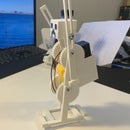Introduction: CS291I Week3 Project
In week3 assignment, we are going to design a lamp shade. Firstly, I created a light bulb holder to test and ensure my design dimensions are correct, so that the upper part of lamp shade and the lamp stand can be connectly more coherently. Then, I designed a lamp shade in Rhino with Grasshopper, and merge the holder to the bottom of the shade. For the lamp shade, I got the idea from my cat, and designed a geometry that is similar to the face of a cat.
Supplies
Rhinoceros, GrassHopper, 3D printer, Cura3D
Step 1: Designing the Holder Structure
I started with the measurement. The diameter of the stand of the light bulb is 4 cm, and the vertical distance is 1 cm.
In Rhino, I drew two circles with 4 cm in diameter, with 1 cm difference in z axis. Then I used offset curves to make the wall thickness to be 2 mm. By using two lofts to create a uniform surface between the two circles and two offset circles, I made two surfaces with 2 mm offsets. After that, I used loft to connect the offset surface with the original surface to make this design a solid shape. It took around 30 min to print, and it fits well to the lamp stand.
Step 2: Designing the Lamp Shade
For the design of lamp shade, I had two directions in my mind. First, it should be similar to the cat face, and second, it should have some hollow structure that allows the light to pass through to make the lamp functional.
I found a useful tutorial on youtube to fulfil the second condition:
Basically, I made half of the area of the lower part of the lamp shade hollow, and created cat face structure in the upper part. The input to the grasshopper is five circles, with the lower two circles specifying the hollow part, and the upper three circles with two opposite control points lifting in z-axis, which is used to create the shape of the ears.
For the lower part, I first used loft to create a surface between the two circles. Then, I employed divide domain to separate the lower surface in vertical direction to 50 pieces. After that, I used a cull pattern to remove one of the divided surfaces in every two, by specifying the cull pattern to "True, False" bit mask. Later, I used offset surface to create solid from the surface with 2mm as thickness.
For the upper part, I stick with the shape of the three modified circles and used loft to create this simple shape. I also used offset surface to create solid from this surface. By merging the upper and lower part, my design from grasshopper is almost done.
By baking the merged part and getting the model in Rhino, I created two identical spheres, placed them in suitable places, and used difference to subtract the original model with these two spheres to create two eyes. The final step is to place the holder part on the bottom, and union these two parts to get the whole lamp shade.
Step 3: Exporting to Cura3D and 3D Printing
By exporting the design to .stl format, I opened it in Cura3D to check if it is structurally printable. There are minor areas where it says need support, but I printed the whole structure out without the support structure. The whole printing precedure takes 11 hours, and it is lucky the printer does not encounter weird situation.
The .3dm .gh .stl files are here: https://github.com/huakehe/LampShade3D













